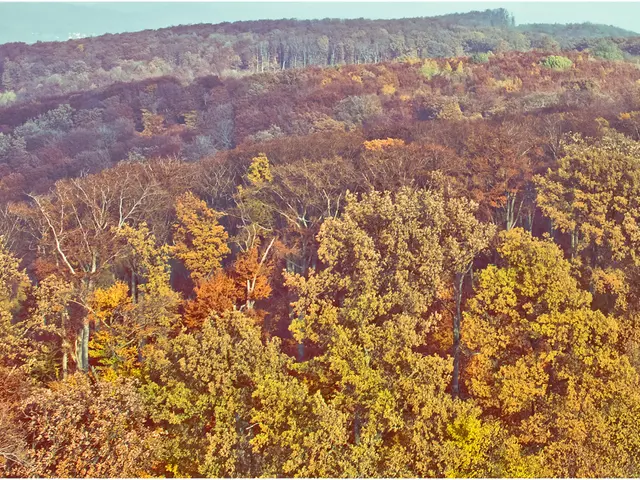Swift Action Needed! Quickly Eliminate These 15 Intrusive Vegetation Species from Your Garden Immediately
In the ever-evolving world of flora, invasive species pose a significant threat to native vegetation and ecosystems. These aggressive plants, such as the Japanese Knotweed and Himalayan Blackberry, displace native plants, disrupt ecosystems, and in some cases, pose health risks. Here's a comprehensive guide, based on recent authoritative sources, to help you identify and manage these invasive plants, along with effective control or removal methods:
The Invasive Plants to Watch Out For
- Japanese Knotweed (Reynoutria japonica)
- Control: Cut back repeatedly to weaken roots; dig out roots and rhizomes completely; professional herbicide treatment recommended.
- Himalayan Blackberry (Rubus armeniacus)
- Control: Prune mature canes; dig out roots; targeted herbicide application; use goats for eco-friendly large-scale removal.
- Common Reed (Phragmites australis)
- Control: Cut close to the ground; treat stumps with herbicide; remove dried material; seek professional help for large infestations.
- Garlic Mustard (Alliaria petiolata)
- Control: Pull plants in early spring; bag and dispose carefully; repeat annually to prevent regrowth.
- Autumn Olive (Elaeagnus umbellata)
- Control: Cut at ground level and apply herbicide; remove seedlings; replace with native berry-producing plants.
- Giant Hogweed (Heracleum mantegazzianum)
- Control: Wear protective clothing; cut and dispose properly; herbicide treatment; avoid skin contact due to toxic sap.
- Rhododendron (Rhododendron ponticum)
- Control: Cut and remove plants; herbicide treatments; manual digging; mulch to suppress regrowth.
- Himalayan Balsam (Impatiens glandulifera)
- Control: Pull before seed set; remove all plant material; repeated control needed to prevent recolonization.
- Purple Loosestrife (Lythrum salicaria)
- Control: Volunteer removal; biological controls used in some regions; cut and bag flowers before seed dispersal.
- Buckthorn (Rhamnus spp.)
- Control: Cut and treat stump with herbicide; dig out young plants; remove fruiting bodies to prevent spread.
- Dog-strangling Vine (Cynanchum rossicum)
- Control: Pull or dig out; repeated removal needed; targeted herbicides in severe cases.
- Yellow Hawkweed (Pilosella aurantiaca)
- Control: Hand pull small patches; herbicides may be needed; monitor and follow up yearly.
- Oxeye Daisy (Leucanthemum vulgare)
- Control: Dig out roots; mow before seed sets; herbicide spot treatment if widespread.
- Queen’s Anne Lace/Wild Carrot (Daucus carota)
- Control: Mow regularly; pull small infestations; herbicide application if required.
- Mullein (Verbascum thapsus)
- Control: Dig out rosettes; hand pull seedlings; mow before seed production; spot herbicide application for large growths.
Key Control Strategies
- Physical removal: Digging roots and cutting back plants repeatedly to exhaust their reserves.
- Herbicides: Targeted chemical treatments applied when plants are actively growing, focusing on cut stems or stumps.
- Biological controls: Such as goats to graze certain invasive shrubs.
- Proper disposal: Bagging and removing plant material to avoid seed spread.
- Annual follow-up: Repeated monitoring and removal efforts are essential for persistent invaders like garlic mustard and dog-strangling vine.
Several of these species, like Japanese knotweed and giant hogweed, also pose legal and safety concerns requiring professional management or protective measures during removal. This overview represents common, high-impact invasives found in many temperate regions, including North America and parts of Europe. Specific control methods should be adapted based on local regulations and environmental conditions.
Identifying and managing invasive plants is crucial to protecting your garden and the local environment. Many of these species thrive because they lack natural checks, so proactive removal is vital. Choose native plants to replace invasives, and consult your local extension office for support in tackling persistent species.
The Common Reed forms monocultures in wetlands, displacing native species and altering ecosystem dynamics. Control tips include cutting plants close to the ground and treating stumps with herbicides, removing dried plant material to reduce fire hazards, and seeking professional help for large infestations.
- In the garden, it's essential to be aware of invasive species like the Japanese Knotweed and Himalayan Blackberry, which can disrupt native vegetation and ecosystems.
- When dealing with invasive plants such as the Himalayan Blackberry, consider eco-friendly control methods, such as using goats for large-scale removal.
- Soil science plays a critical role in landscaping, as the right soil conditions can help native plants thrive while minimizing the spread of invasive species.
- Planting flowers is an enjoyable part of the home-and-garden lifestyle, but careful consideration of native and invasive species is necessary to maintain a healthy and eco-friendly garden.
- Environmental-science research has identified several invasive plants commonly found in North America and parts of Europe, including the Common Reed, which can alter wetland ecosystems.
- Decorating your garden with native plants not only improves its aesthetic appeal but also supports local biodiversity and helps protect the environment.




